Las Vegas and the MIX Conference 2007
I travel to Vegas for a Microsoft web conference. Meanwhile, Read/WriteWeb doubles traffic and breaks into the Technorati top 30.
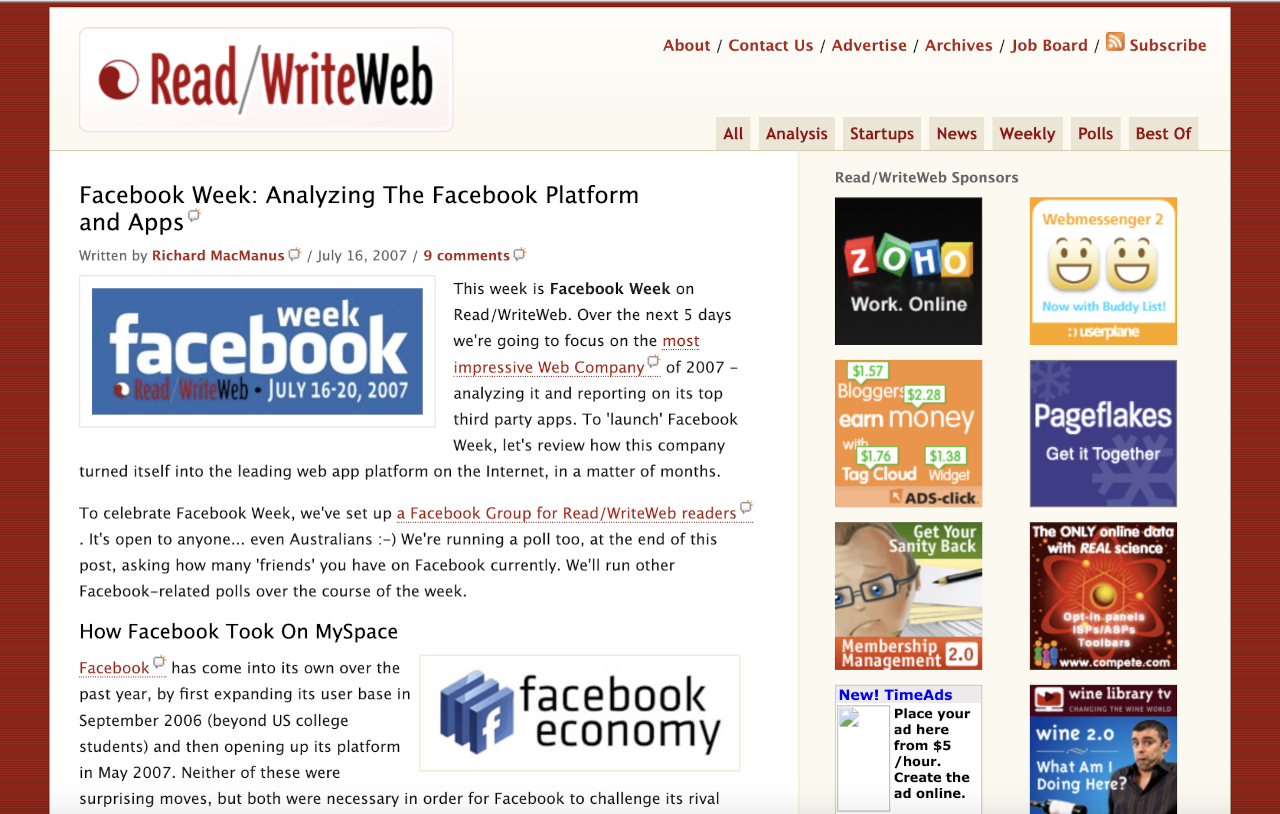
After the Web 2.0 Expo, it was off to Las Vegas for Microsoft’s MIX conference, an event to promote the company’s web technologies. My travel, including accommodations at the Venetian on the Strip, was being paid for by Microsoft New Zealand. My wife flew over from NZ to join me for the Vegas trip, which I was able to pay for thanks to Read/WriteWeb’s current profitability.
When we arrived at the Venetian, I was at first impressed by its sense of grandeur. The hotel had only opened in 1999, so it felt brand new with its polished stone floors, gleaming white granite columns, and golden roof with copies of old Italian art. Of course, I soon gathered that everything in the complex was copied from Venice, including a version of St. Mark’s Square (with a large ice-cream shop at its center), replica sculptures, staff members dressed as statues, and gondola rides offered on canals within the walls of the hotel. At that time I had never visited Venice or anywhere else in continental Europe, so I had nothing to compare it to. Even so, it all felt like a giant fraud, which made my heart quietly sink during that first day. I realized that I wanted to see the real things, to feel what life was like in the real Venice. I resolved to make that happen one day.

Stranger in a strange land; me at The Venetian, 28 April, 2007.
The other thing that hit me about Las Vegas was the extreme heat. It wasn’t even summer yet, but walking outside during the day was almost unbearable. Fortunately, I’d be spending most of my days in the air-conditioned Venetian conference center.
The focus for MIX this year was a new product called Silverlight, Microsoft’s version of Adobe Flash. It would support what the industry called “rich internet applications” (usually shortened to RIA), which meant running high-definition video and other interactive media on the web. Just like Flash, Silverlight required a browser plug-in for users, which was provided for free for both PCs and Macs.
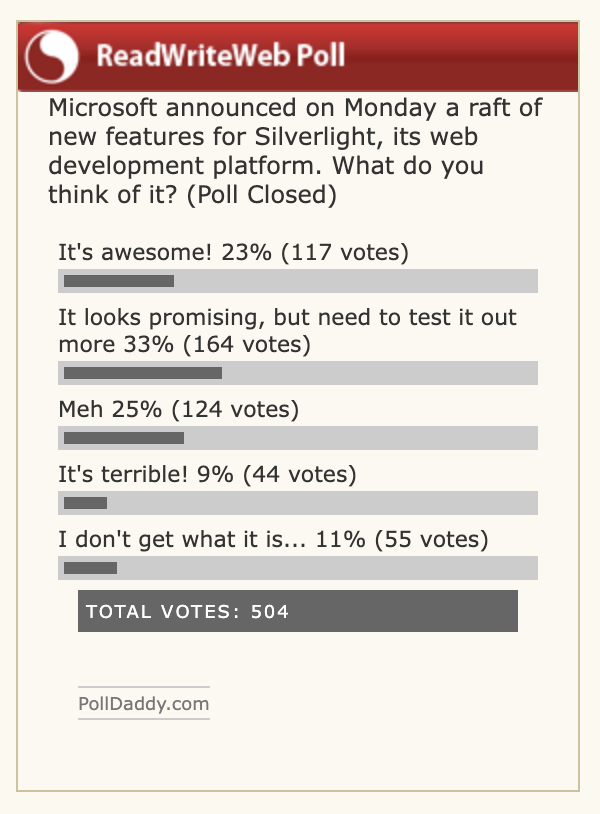
One of the neat community tools we had on the site by 2007 was polls, provided by PollDaddy.
As part of the marketing push for Silverlight, I was invited to a blogger lunch with Microsoft executives Ray Ozzie and Scott Guthrie. Ozzie had taken over from Bill Gates as Microsoft’s chief software architect the previous June, so he was still relatively new to his role—and, of course, replacing Gates at Microsoft was always going to be impossible. He was fifty-one and looked the part with his swept-back silver hair and Gates-like glasses. But in person, he came across as reserved and not entirely comfortable in the limelight. Whereas Gates always reveled in being the smartest person in the room—and made sure that you knew it—Ozzie seemed reluctant to accept that responsibility.
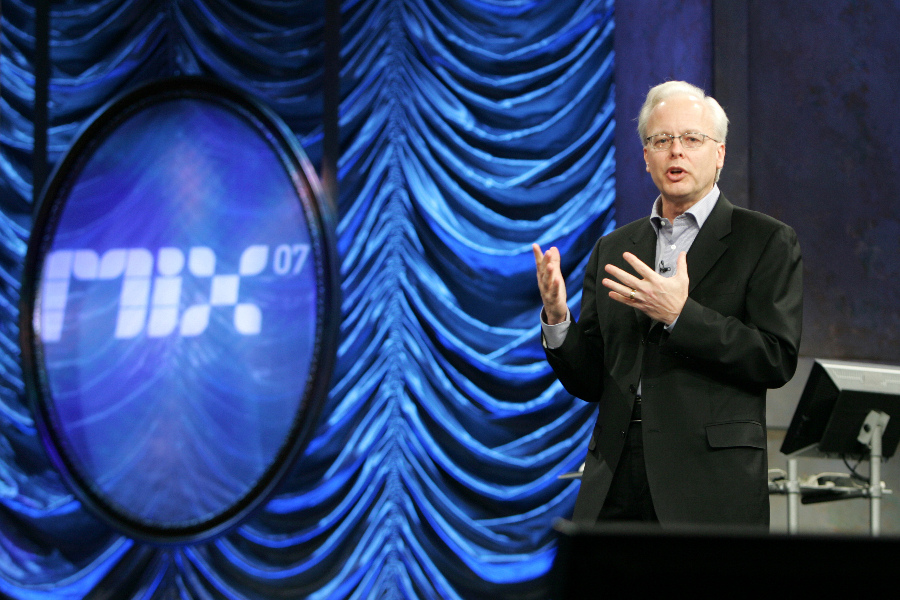
Ray Ozzie on-stage at MIX 2007; photo by Jeff Sandquist
Mike Arrington was at MIX too, but he wasn’t at the lunch. Mike had interviewed Ozzie and Guthrie onstage that morning, and it turned out he’d had extensive briefings with Microsoft already. I enjoyed the lunch, but I took a long time to get a question in to Ray. I had the same problem at corporate meetings: finding the appropriate time to pipe up and contribute to a group conversation wasn’t a strong point of mine. While I was working up the courage to say something, Evan Williams—the CEO of Twitter, but also a pioneering blogger—noted that Silverlight was going to be great for his team because they could build a Silverlight application for Twitter using the same skillset used to build the web version of Twitter.
Right at the end of the lunch, I finally managed to get a question in for Ozzie about Microsoft’s strategy for its Internet Explorer (IE) browser. IE still had between 75 percent and 85 percent market share (depending on which source you used), with only Mozilla Firefox in the double digits as a competitor. As had now become the norm, there was little sign of innovation in IE due to its dominance. What’s more, the latest version, IE7, was the least standards-compliant browser of the time. When I asked my question, I noted that Firefox was on the road to becoming what Mozilla termed an “information broker”—in other words, not just rendering HTML, but integrating with other applications (such as a calendar app). Other browsers were innovating, so I was fishing for a sign that Microsoft would use Silverlight as an excuse to start innovating again on browser technology.
Ozzie replied that Microsoft was creating a platform for developers to build componentized things, such as widgets and other web services. He didn’t elaborate on IE’s future role in this, saying only that the next version of IE was under wraps. His response didn’t give me much to write about.
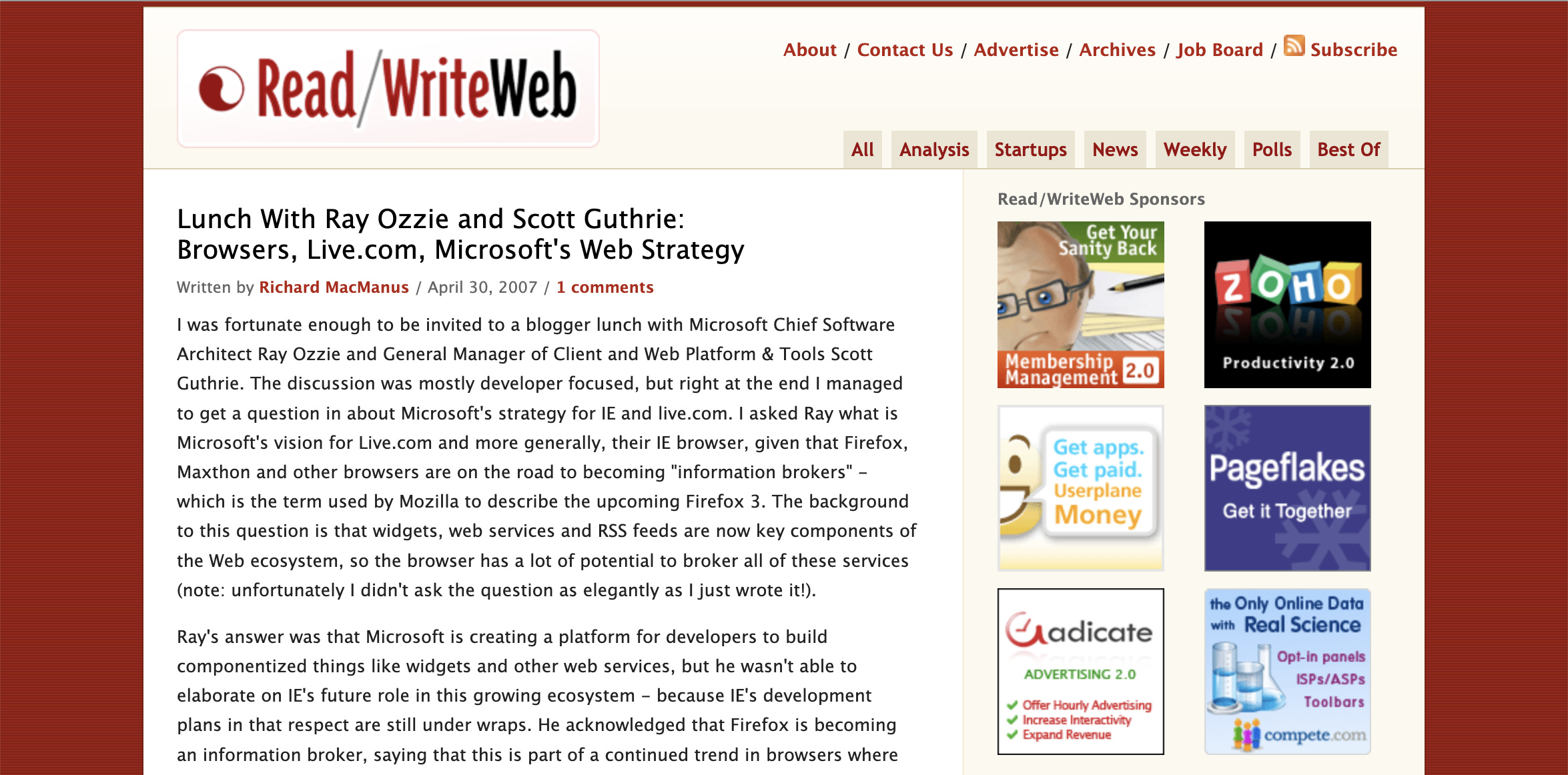
My RWW post about the blogger lunch; alas, there were no photos allowed (or at least, I couldn’t find any online nearly 17 years later).
As the assembled bloggers were walking out of the lunchroom, I struck up a conversation with Williams. I mentioned that I’d joined Twitter the previous month and was enjoying it, but that someone was squatting on the @readwriteweb handle. He replied with a smile that the @rww username was actually better because it was shorter, which made it easier for other users to @ me. That was the last time I complained about the squatter.
When I was back in New Zealand, I emailed Emily Chang and Max Kiesler to ask if Ideacodes would be interested in doing the next Read/WriteWeb redesign. Among other things, I wanted to “find a better solution for the ads, lists, network links, etc.” in the header and sidebar areas. I knew the redesign would have to scale with RWW’s growth, including the new network blogs. Emily wrote back saying they were keen to take on the work.
The sponsor ads and the advertising supplied by FM Publishing, along with other bits and pieces such as a job board and Feedburner RSS ads, were now bringing in significant revenue. In June I’d made over $25,000 from RWW alone. My expenses were still low—I paid Josh an hourly rate for 12.5 hours per week (it later became 30 hours per week), hosting fees were reasonable, and the only other regular expenses were for things like banking and PayPal fees. Even the network costs were small. The ASE design had cost around $2,000, but that had paid for itself within a month or two due to a quick start with sponsors. By any measure, RWW was a very profitable small business.
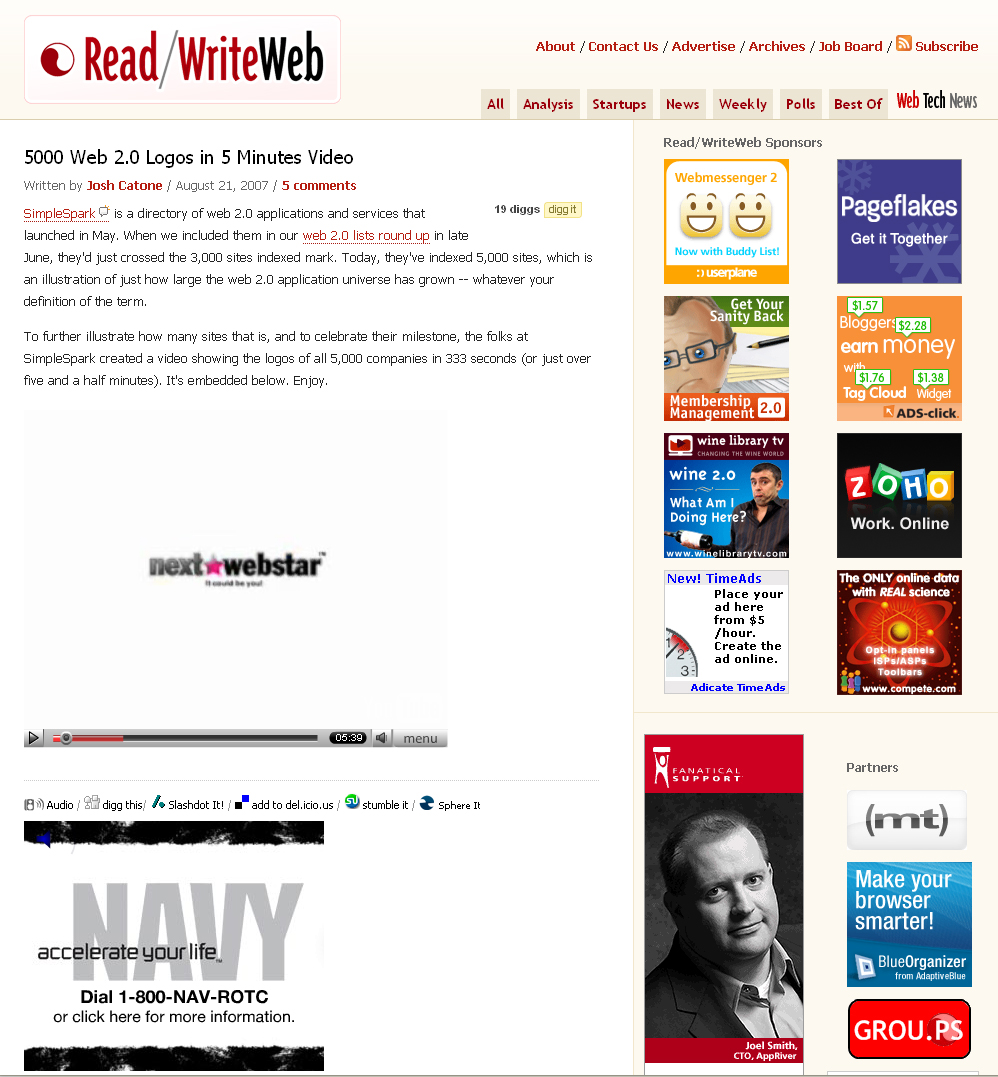
A screenshot taken in August 2007, which shows how many ads I had running at the time.
The Web 2.0 industry was now big business. This was confirmed by the sale of two large advertising networks to tech companies in the first half of 2007. First, in April, Google acquired the online advertising platform DoubleClick for $3.1 billion. Microsoft quickly countered the following month by buying a digital marketing company called aQuantive for $6 billion. While I didn’t use those platforms, RWW was—in its own small way—among the beneficiaries of record internet ad spending that year.
As if to emphasize that web business was expanding at great speed, Facebook announced a developer platform in May that enabled third-party companies to integrate their services inside the fast-growing social network. This was the news that finally impelled me to join Facebook! It’s strange to think now, but at the time Facebook was not the most popular social network on the internet—particularly outside of the United States. Facebook had twenty-four million global users at its platform launch, but it was far behind MySpace at sixty-seven million. Indeed, in some countries, Facebook was the third biggest social network (in the UK, Bebo was more popular than MySpace).
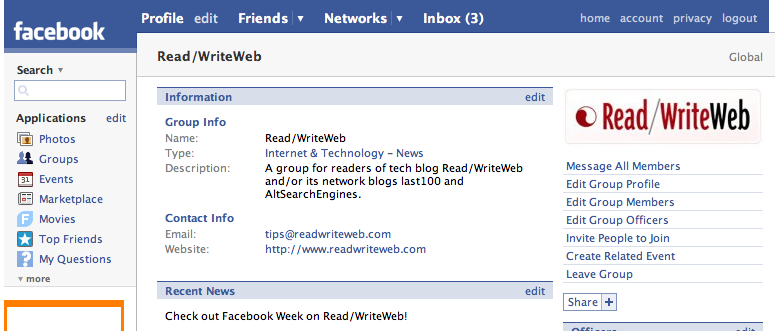
In July 2007, I set up a RWW group on Facebook.
But part of the new appeal of Facebook was that third-party developers could potentially make money from their apps, thanks to the developer platform. “You can build a real advertising business on Facebook,” Mark Zuckerberg told developers and journalists. As I put it in my blog post about the launch, Facebook had “grown up”—it was obviously now much more than a social network for American college students.
RWW continued to grow rapidly in terms of page views and subscribers. By mid-2007 it was among the world’s top 30 blogs, according to Technorati’s list of “the biggest blogs in the blogosphere, as measured by unique links in the last six months.” Heading into the second half of 2007, RWW was at number 29—nestled just behind Gawker and in front of Instapundit. I was now ahead of GigaOm (33), although Mashable had overtaken me and, at number 17, was within range of competing with the mighty TechCrunch (4).
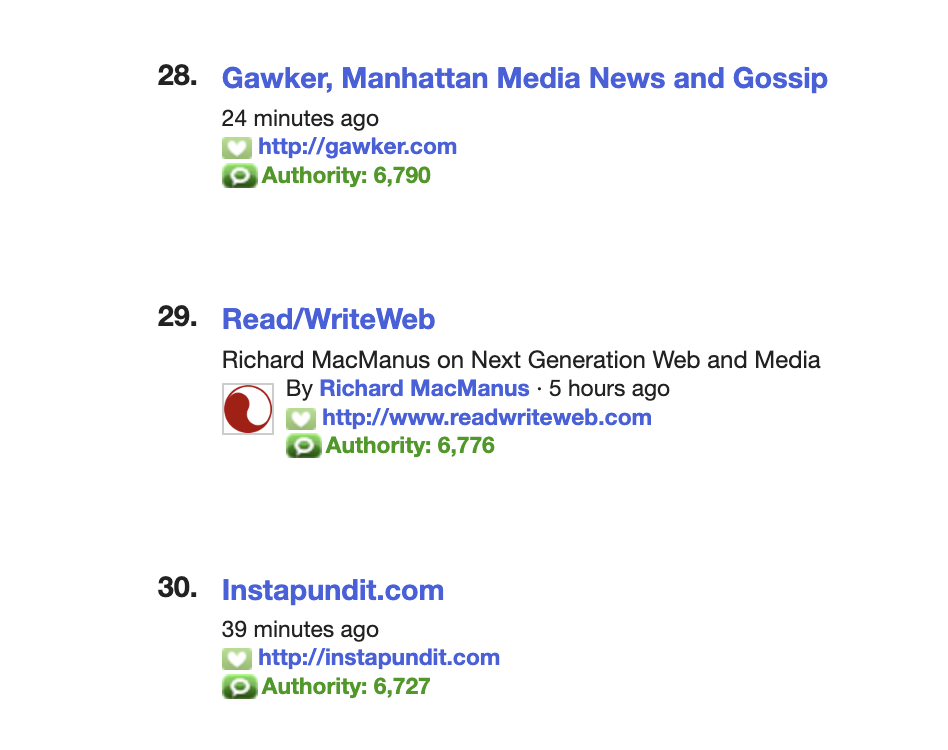
RWW was inside the Technorati top 30 by mid-2007; image via Technorati.
By August RWW was getting 775,000 page views per month—nearly double what it had been at the end of 2006. The RSS and email subscribers had also more than doubled, to nearly 90,000. It was heady stuff, and I was putting a lot of energy into figuring out how to sustain this growth rate. I jotted down in my notebook that I needed another daily writer and a webmaster to take over technical maintenance of the websites. In hindsight, I should’ve been thinking of staffing up more aggressively, but I was still learning how to be a media entrepreneur on the go.
I’d written up a three-page document for Emily and Max, outlining my goals for the site redesign. First and foremost, I wanted a “modern, sophisticated design that shows that RWW is a professional, high quality media property.” I noted a lot of other technical and practical elements as well. For instance, I wanted to make sure that RWW continued to be a social hub for people interested in Web 2.0. One of my listed goals was to “encourage community and in particular comments.” “It is crucial that we encourage discussions on the site and I regard this as #1 priority for the site overall,” I added. Clearly, this was well before the time when social media began draining away conversations from blogs.

In August 2007, I made an appearance on national TV, talking about Facebook on a morning news program.
In mid-August Emily and Max sent me a proposal for the redesign work, including a generous “friends’ rate” for the project. At the same time, I was having discussions with Six Apart (owners of Movable Type) and my web hosts Media Temple about upgrading our server setup. In addition, I was figuring out my taxes and investigating a business plan involving premium content.
With the business planning, redesign, publishing platform upgrade, sponsor management, SEO, and finalizing agreements with Steve and Charles on the network blogs—not to mention writing several RWW articles every day—I was now very stretched on the work front. I was trying to defocus other demands on my time. I’d been having informal discussions about a RWW China site with a guy named Gang Lu. But I hit pause on that. Among a list of things I wrote down in my notebook under the heading “Defocus” was this: “emails (do auto reply?).” But alas, generative AI software was still many years into the future.
One project I didn’t put off was a new podcast site to be run by Sean Ammirati, called Read/WriteTalk. I’d learned my lesson about using the RWW branding for a new network blog. I set up a space on the server and handed over the design template, and Sean did most of the work to create the new site. It was his idea, and I was pleased to have a podcast site up and running under the RWW banner.
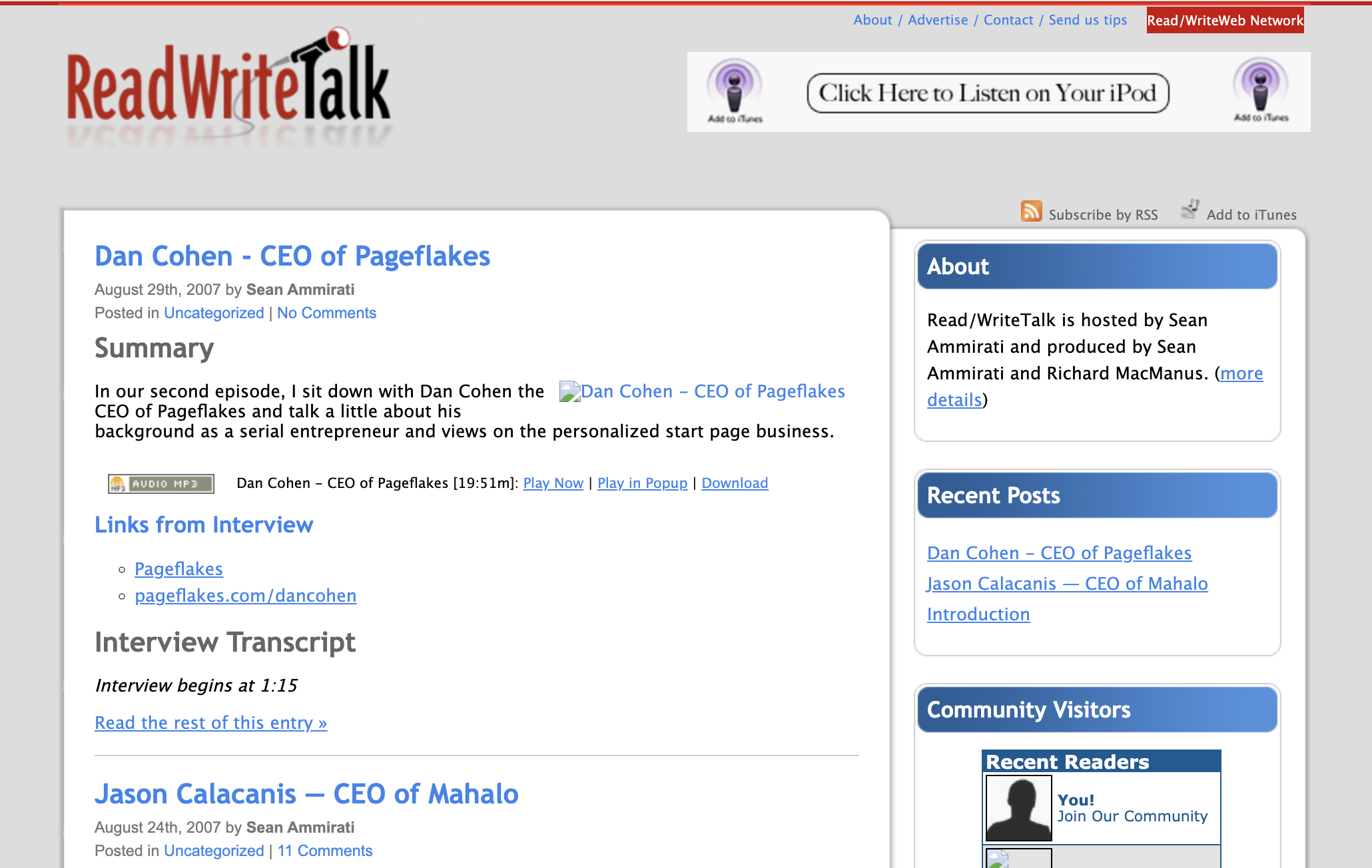
Read/WriteTalk, our podcast, was launched at the end of August 2007.
I announced Read/WriteTalk (tagline: “The people behind the web”) at the end of August. We had quietly launched the site in mid-August, but I wanted to tidy up some of the design aspects before I publicized it on RWW. However, I was unexpectedly beaten to it by Valleywag, the notorious Silicon Valley gossip site operated by Gawker. Sean’s first interview was with Jason Calacanis, the New York entrepreneur who had sold Weblogs, Inc. to AOL in 2005. Calacanis was on Valleywag’s hitlist of tech personalities to snoop on (another was Mike Arrington), and they did a short post based on a quote from his Read/WriteTalk episode, in which Calacanis had compared entrepreneurs to samurai. It no doubt titillated the Valleywag readers, but also drew attention to our new podcast.
When I calculated my monthly revenue for August, it added up to nearly $34,000—a new record for RWW. FM Publishing had really come to the party that month, as $15,000 of it was from their CPM adverts. Given these increasingly big paydays and the still relatively low expense base for RWW, I knew it was high time to invest in more writer talent.
This post is part of my serialized book, Bubble Blog: From Outsider to Insider in Silicon Valley’s Web 2.0 Revolution. View table of contents.
Next up: 024. Read/WriteWeb Makes Key Hire & I Meet Hustle Culture
You're reading Cybercultural, an internet history newsletter. Subscribe for free, or purchase a premium subscription. Your support for this indie publication would be greatly appreciated.